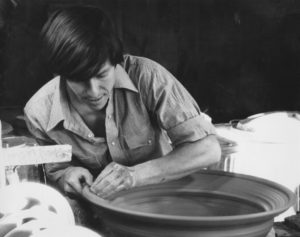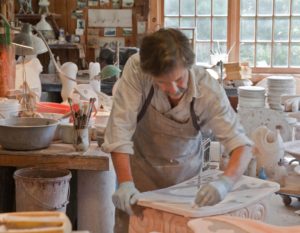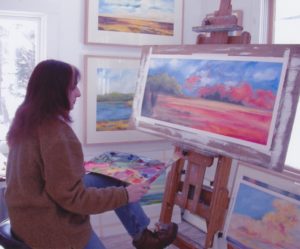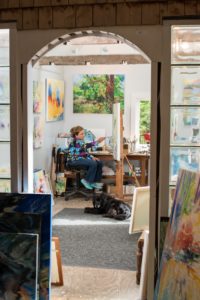By Margot Torrey
Craftspeople have always played a part in the life of Putney, as in most New England villages. Blacksmiths, woodworkers, weavers, knitters and quilt makers made useful and beautiful objects that filled the needs of everyday life while adding aesthetic pleasure to house or wearer.
The Arts and Crafts movement of the turn of the 20th century encouraged the appreciation of handmade objects and influenced the thinking of some patrons decorating their houses. Although fairs such as the one at Sunapee, New Hampshire, had been showcasing and selling handcrafted goods to connoisseurs for years, it wasn’t until the 1960s that a real change began in the focus of attention of the society at large on craftwork as highly desirable as possession and profession. Turning away from conventional jobs and 9-5 office hours, more college graduates with a creative bent and others who wished to live a self-actualizing life in a rural setting turned to the potter’s wheel or the lathe to fulfill their dreams and struggle to earn their living.
In Putney, the Putney School always gave respectful grounding in the arts, giving students an opportunity to try their hands at various media. Antioch University Graduate School of Leadership and Change and Windham College furthered the expertise of their wishing to pursue their creative potential. One result was that a number of graduates returned to the place that had nurtured them, and settled in Putney. At first, the culture clashes of the sixties and seventies—the town/grown stereotypes of hippies vs. old-time Vermonters that existed in so many communities—threatened to alienate one segment of the population from the other, but it gave way to a more tolerant acceptance and, finally, appreciation.
As word spread through the growing crafts community that Putney—accessible, yet rural situated along the beautiful Connecticut River—was a fertile setting providing attractive locations for studios and the companionship of other like-minded people, more and more migrated to the hills and valleys of Putney. By 1981, more than 100 names are listed in a Putney Artisans Directory. Many of these artisans were known for their work at big-juried craft shows. As the respect for fine craftwork and the desire to own it grew in the society at large, the name Putney became increasingly associated with professional crafts, drawing residents and those in search of beautiful objects to take home—a cherry table by Richard Bissel, perhaps; a large decorative pottery piece by Ken Pick; ornamental tiles by Carol Keiser; fine fimo earrings by Susan Samitz; a turned burl bowl by Wendy Wilson; a soft fiber dress by Marcia Hammond.
Inspired by her research presented to the Fortnightly Club in 1981 about Craftspeople of Putney, Margot Torrey, a woodcut printmaker and organizer fresh from 25 years in independent schools, put out an invitation to craftspeople to a get together. At a subsequent series of potluck suppers, as work spread and more were welcomed to the circle, an informal organization was formed: The Putney Artisans League. It was dedicated to an exchange of information of mutual interest, to projects such as a directory of Putney artisans and, eventually, to a plan for an all-Putney Artisans Festival. Two pages of names on a petition persuaded the Selectboard to allow the venue to be the Town Hall and its grounds.
The first festival, enhanced by local food vendors and such musicians as Fred Breuning and Alan Blood, took place in September 1981. It was repeated in ‘82 and ’83. The stated purpose of the festival was multifaceted: to show the local community what was being made here in the studios hidden away in barns and houses across the countryside; to enjoy one another’s work; and of course, to sell the work of their hands to local and visiting buyers. With the help and participation of Bill Sam Caldwell, Dale Good, Ian and Jenny Eddy, Adam and Debbi Wetzel, Ken Pick, Judy Hodson, Bob Burch, Deborah Buma, Lilli Crites, Nora and Jim Zellmes, Elizabeth Lewis, Robert Olson, and many others, the crafts community introduced itself to Putney. It was a festive event for all participants.
When Ian and Jenny Eddy (blacksmiths) and David and Carol Mischke (potters) began joining forces to put on a Christmas Open House and Seconds Sales, the idea arose of adding to the list of open studios, and the seeds of the Putney Holiday Craft Tour were planted.
Although the tour was begun as a hospitable commercial venture, many of the craftspeople who joined felt that in celebrating the process—by demonstrating how the work was made, in the setting where it happens—they would give the public not just interesting entertainment but also new respect for the value of the finished product. It was this aesthetic and educational aspect as much as the commercial one that provided the stimulus to keep it going. As the persistent organizer, Margot Torrey called together each spring the current resident independent craftspeople to form a group and do it once again. Sharing the many tasks involved, they produced the tour of crafts studios in Putney. The tour became such a very successful enterprise and was so enjoyed by participants from far and wide that it became a model for the Vermont Crafts Council and many other communities in Vermont and elsewhere.
People from great distances and from nearby bring their pocketbooks to restaurants, inns, and other local businesses, as well as the craft studios they came to visit. This reality is appreciated by Putney businesses that in turn contribute funds for publicity for the tour.
Another early tour member: the Green Mountain Spinnery, chiefly engaged in machine spinning and dyeing of yarn from New England fleece, also—since its founding as a cooperative in 1981—marketed sweater patterns designed by Putney artists to go with their array of many colored yarns.
Craftspeople in Putney have worked with the schools, offered workshops to children, and have taken on apprentices, as did Bob Burch, glassblower. He and others open their studios at various times of the year for demonstrations and sales, adding to the numbers of travelers brought to Putney for its artistic offerings.
In its 40-year history the tour has had more than 100 participating artisans, a remarkable number considering the size of the small town of Putney. Some participated for a year or two and others for 10 years or more. For three founding members—glassblower Bob Burch and potters Ken Pick and David Mischke—this will be the 40th year that they have shown the public their studios where they create their unique pieces. For Burch, the tour is a family affair with daughter Caitlin, a jewelry maker, and Ryan, who makes functional ceramics joining the tour.
In addition to the studio visits that people have enjoyed every year there are always new members on the tour, new studios to see, new demonstrations of craft to educate and entertain, and new insights into the creative process.
Margot Torrey, who died in 2017 at age 89, left this history of the Putney Craft Tour, and we are pleased not only to commemorate the tour on this milestone anniversary but also honor her contributions to the vibrant community of Windham County artists and craftspeople. Visitors can visit http://www.putneycrafts.com to preview the 25 working studios in Putney for this year’s tour, which will take place this Thanksgiving weekend.

























































